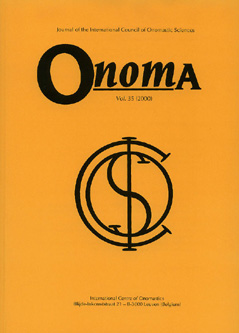 previous article in this issue previous article in this issue | next article in this issue  |

Preview first page |
Document Details : Title: Die historischen Voraussetzungen für den Eigennamenstatus von Produktnamen Author(s): LÖTSCHER, Andreas Journal: Onoma Volume: 43 Date: 2008 Pages: 25-56 DOI: 10.2143/ONO.43.0.2062447 Abstract : Der onomastische Status von Produktnamen ist problematisch, denn sie zeigen manche Ambivalenzen zwischen Appellativ und Eigenname. Der vorliegende Beitrag versucht eine Klärung dieser Problematik. Ausgegangen wird vom Grundgedanken, dass es universale Kriterien der 'Namenhaftigkeit' von sprachlichen Zeichen gibt, dass aber die Konkretisierung in Namen sich historisch differenziert ausprägt, in Abhängigkeit von der Struktur des Objektbereichs, in dem die Namen verwendet werden, und von den besonderen gesellschaftlichen Bedingungen der Namensbildung. Die traditionelle Onomastik beschäftigt sich mit elementaren Phänomenen wie Namen für Personen und Orte. Diese Gegenstandsbereiche unterscheiden sich in wichtigen Punkten von jenen von Produkten in der neuzeitlichen industriellen Massenproduktion, und so können die für ihre Beschreibung entwickelten Konzepte nicht ohne weiteres eins zu eins auf Produktnamen übertragen werden. Zwei besondere Aspekte werden herausgearbeitet: Konsumgüter erscheinen als mehrschichtige Objekte auf mehreren Ebenen, als Modelle und als deren Replizierung in einzelnen Gegenständen, oft dazu noch als rein intellektuelle Objekte wie Computerprogramme oder Design. Die sprachtheoretische Analyse von Produktnamen muss in Beziehung gesetzt werden zu dieser vielschichtigen Existenzweise von Produkten. Zweitens ist ein Produktname immer ein Eigenname eines Erzeugnisses eines bestimmten Anbieters, nicht einfach einer besonderen Art von Gegenständen. Produktnamen sind, wenn man den Objektbegriff erweitert, so zwar auf bestimmten Ebenen beschreibbar als Eigennamen im strengen Sinn, die Beschreibung muss aber entsprechend der Vielschichtigkeit der Produktexistenz differenziert werden. The onomastic status of product or trade names is problematic, as they show much ambivalence between proper names and appellatives. The present contribution aims at clarifying these problems. The basic assumption is that on the one hand there are universal criteria for the propernamehood of linguistic signs, but that on the other hand the nature of concrete proper names is dependent on historical conditions, the structure of reality to be named and the particular social conditions for naming individuals. Traditional onomastics focuses on elementary types of proper names such as personal names and place names. These areas differ from that of mass production in an industrial society in important respects. Thus the concepts developed for describing personal names or place names cannot be transferred one-to-one to the description of product names. Two important aspects are developed: First, consumer goods appear in the economic world as multiple phenomena on different levels, as types or models on an intellectual level, and as replica on a physical level. There are even products that exist on a purely intellectual level, such as computer programs or design concepts. The theoretical analysis of the semantic status of product names has to be related to the multiple levels of the existence of products. Second, a product name always is a proper name by the fact that it is the name of a product commercialized by a particular individual, and not just a name for a type of object as such. Within this approach, product names can be described as proper names in a strict sense on a particular level, but the description has to be differentiated according to the different levels of the existence of products. Les noms de produits ont un statut onomastique problématique, car ils montrent certaines ambivalences entre noms propres et noms communs. Cette contribution vise à clarifier ces problèmes. Elle est fondée sur l’idée que, d’une part, il y a des critères universels de proprialité des signes linguistiques, et que, d’autre part, la nature des noms propres particuliers dépend des conditions historiques, de la structure de la réalité décrite et des conditions sociales particulières déterminant la formation des noms. L’onomastique traditionnelle se focalise sur les types élémentaires de noms propres tels que les noms de personnes ou de lieux. La structure de ces domaines diffère de celle de la production de masse de biens de consommation dans une société industrielle par rapport à des aspects essentiels. C’est pourquoi les concepts développés pour la description des noms de personnes ou de lieux ne sont pas applicables tels quels à la description des noms de produits. Deux aspects particuliers sont développés. Premièrement, les biens de consommation ont une existence à plusieurs niveaux, comme modèle à un niveau conceptuel d’une part et comme objets à un niveau physique d’autre part. Il existe par ailleurs des produits qui n’existent qu’à un niveau intellectuel, tels que les logiciels ou les conceptions de design. L’analyse théorique des noms de produits doit être mise en relation avec ces différents niveaux d’existence des produits. Deuxièmement, un nom de produit est un nom propre se rapportant à un objet commercialisé par un individu particulier ; il ne s’agit pas d’un nom propre se rapportant à un objet anonyme. Dans le cadre de cette approche, il est possible d’analyser les noms de produits comme des noms propres dans un sens strict à un niveau défini et délimité ; de l’autre côté, la description doit être différenciée selon les différents niveaux d’existence des produits. |
|


